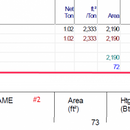Manual J Comparison Help – Terminology
Hey All,
BLUF:
Can someone help me match which term in #1 is
Heating Load =
Cooling Load =
MANUAL J #1: Sensible Gain, Latent Gain, Net Gain, Sensible Loss
MANUAL J #2: Heating Load, Cooling Load
DETAILS:
I had a Manual J completed prior to talking to the local HVAC company. Then, the local company generated another Manual J prior to completing the Manual S and D. I understand that they likely re-accomplished the Man J to 1) ensure that the System and Duct designs were accurate and 2) to easily import the data into their Man S & D software.
A cursory comparison showed
30% increase to both Total Heating Btu and Total Cooling Btu.
50% Total CFM increase.
Each Man J uses slightly different terminology and I need help to ensure that I compare the correct numbers (see atch’d image).
I am pretty sure that Sen. Gain and Latent Gain form Net Gain. But which one in #1 is Heating Load and which is Cooling Load. My guess (from some research) is that Net Gain is Cooling Load, but I am not at all confident in that response.
PS. I tried ChatGPT and got the following — if you are interested. The second response just flipped the answer for #2 & #5.
First Response:
1. Area: Matches with Area.
2. Sensible Gain: Matches with Heating Load.
3. Latent Gain: Does not have a specific match from List two.
4. Net Gain: Does not have a specific match from List two.
5. Sensible Loss: Matches with Cooling Load.
Second Response:
1. Area – Matches with Area in List two.
2. Sensible Gain – Matches with Cooling Load in List two.
3. Latent Gain – Does not have a specific match in List two.
4. Net Gain – Does not have a specific match in List two.
5. Sensible Loss – Matches with Heating Load in List two
GBA Detail Library
A collection of one thousand construction details organized by climate and house part










Replies
I would ask for the detailed Man J and check they have the right inputs. Man J results typically come from software so if all the inputs between the two match, the outputs should be about the same.
Hard to tell without the actual reports but Sensible Gain+ Latent Gain should equal your cooing load. Sensible loss your heating load.
CFM needed has nothing to do with ManJ, CFM comes from equipment selection. Typically heat pumps run at around 40BTU/CFM for heating.
THanks Akos,
I'll attach both Man J. I did a cursory/layman's review of the manual Js. They look to be mostly the same. There are a couple of room areas that are off by a half a foot here and there, a couple of dry/wet bulb deltas, but the biggest difference seems to be in the u-value of the walls.
First Man J -
R23cav+R10ext: Wall-Frame, Custom, 2x6 framing 16"oc
filled mineral wool, 2" XPS foam continuous, U-value
U-value - 0.034
Second Man J -
12F-6sw: Frm wall, wd ext, 1/2" wood shth, r-21 cav ins, 1/2" gypsum board, int fnsh, r-10 ext bd ins, 2"x6" wood frm, 16" o.c. stud
U-value - 0.048
Some basic math shows the second Man J. value (0.048) as about 41% lower insulation value than the first manual J's value (0.034).
Which has me a bit baffled as the descriptions look very similar -- minus the R21 value error on the second. I plan to ask them to update the R21 to R23. But I wanted to see if I could get a better feel for why these two walls are 41% different. Surely it can't be that R2 delta between them. Can it...?
I wonder if anyone on GBA has access to the ACCA Man J book with the wall tables (I think it's table 4A, Construction #12-Frame Walls)???
I see 0.034 in the description of the wall U-value on the first attachment, not 0.34.
@ matthew25 -- Yep....that was a typo on my part. Fixed that. Thx
Depending on the cladding, the r24+r10 CI wall is about ~ U0.037:
http://effectiver.ca/calculator/wall.php?id=7128
The outdoor design temps are slightly off between the two but not a whole lot.
Maybe the ventilation losses is off between the two. Make sure the proper E/HRV efficiency is used if you are using one, default on some programs is exhaust only which adds a fair bit of extra loss.
Thanks Akos.
I fumbled around a bit on that website...very cool. Though I suspect that if I ref. it here in the lower 48 they'll just say "Canada Eh". :-)
0.034 to 0.37 seems like an acceptable range to me.
Aren't there standard, outdoor design temps based on location? I really thought the basic stuff would match. I want to look up what that value "should" be -- it would be great if I could pull it off of a website, table, etc. referenced by man J.
I do see a line for "Ventilation" on the second one with a value of 4,267 Btuh.
on the second one there is a line for "Ventilation" as well. 696 Net Gain and 2,153 Sen Loss.
I am wondering if the fact that the ventilation Btuh is about double, in conjunction with the the lower wall u-value (0.48), is what is causing the substantial difference between the two.
Attached a screenshot of both.